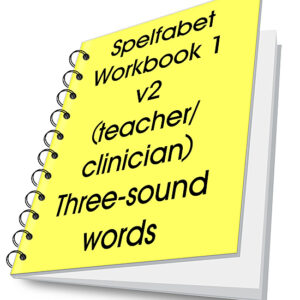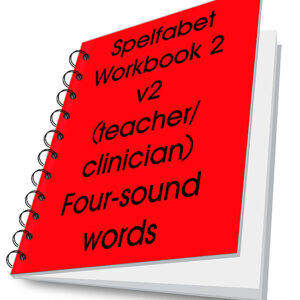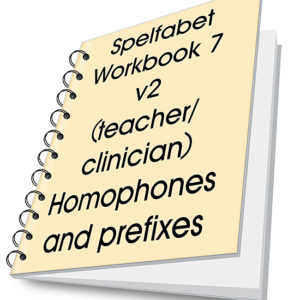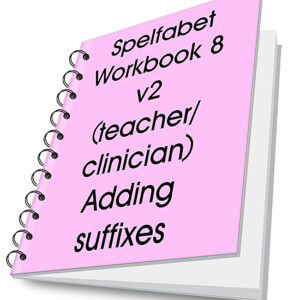Workbook 8 – parent/aide edition
$AUD17.93
Downloadable 126-page illustrated workbook on suffixes which you may print up to 50 times. Expands on previous workbooks covering plural, possessive, past tense, present progressive suffixes, and includes both inflectional and derivational suffixes and associated word ending changes (doubling consonants, dropping final e, changing y to i etc.) as follows:
y as in chat-chatty; er as in clean-cleaner; or as in actor; ive as in attract-attractive; ing as in carve-carving; es as in box-boxes and mango-mangoes; f-ves as in knife-knives; y-ies as in hobby-hobbies; es as in she fishes; er as in bright-brighter; est as in tall-tallest; ful as in help-helpful; ed as in corner-cornered; age as in pack-package; ous as in danger-dangerous; the spelling ci as in ancient; ian as in electric-electrician; ist as in art-artist; ion as in act-action; ly as in brief-briefly; ible as in digest-digestible; able as in fix-fixable; ment as in agree-agreement; ness as in ill-illness; less as in cloudless; hood as in child-childhood; al as in nation-national; en as in fresh-freshen; ish as in child-childish; ance as in distant-distance; ence as in confident-confidence; ism as in magnet-magnetism; ee as in employ-employee; ic as in diagnose-diagnostic; ally as in basic-basically; ary as in necessary; ous as in glamour-glamorous; ise (or US English ize) as in apology-apologise (apologize); US and UK English spellings as in ageing/aging; doubling final l as in cancel-cancelling (not always in US English); diminutive ie as in Australian-Aussie.
Description
126 pages of spelling activities designed for learners of any age who can write words with a variety of vowel and consonant spelling patterns, differentiate homophones and add prefixes to words, and now need to practise adding suffixes to words, and understanding how these meaningful word parts change meaning/word type. View the workbook’s video tour here. Download a free sample of the workbook here.
Activities are straightforward so you don’t need special training or expertise to help a learner use this workbook. It walks you through the task of adding the following suffixes to words to change their meaning:
- y as in bone-bony, chat-chatty,
- er as in clean-cleaner, blend-blender, drum-drummer, run-runners,
- or as in actor,
- ive as in attract-attractive,
- ing as in carve-carving,
- es as in box-boxes, mango-mangoes (but hippo-hippos),
- f-ves as in knife-knives,
- y-ies as in hobby-hobbies (but holiday-holidays),
- es as in she fishes,
- er as in bright-brighter, big-bigger, busy-busier, brave-braver,
- est as in tall-tallest, big-biggest, funny-funniest,
- ful as in help-helpful,
- ed as in corner-cornered,
- age as in pack-package, marry-marriage,
- words that you’d expect to have double consonants like body, copy, edit.
- ous as in danger-dangerous, fury-furious, nerve-nervous,
- the spelling ci as in ancient, delicious, social,
- ian as in electric-electrician,
- ist as in art-artist,
- ion as in act-action, calculate-calculation, declare-declaration, apply-application, discuss-discussion, collide-collision,
- ly as in brief-briefly,
- ible as in digest-digestible,
- able as in fix-fixable, adore-adorable,
- ment as in agree-agreement,
- ness as in ill-illness,
- less as in cloudless,
- hood as in child-childhood,
- al as in nation-national, colony-colonial,
- en as in fresh-freshen,
- is as in child-childish,
- ance as in distant-distance,
- ence as in confident-confidence,
- ism as in magnet-magnetism,
- ee as in employ-employee,
- ic as in diagnose-diagnostic,
- ally as in basic-basically,
- ed as in prefer-preferred,
- ing as in babysit-babysitting,
- ary as in necessary,
- ous as in glamour-glamorous,
- ise (or US English ize) as in apology-apologise (apologize),
- US and UK English spellings as in ageing/aging,
- doubling final l as in cancel-cancelling (not always in US English),
- diminutive ie as in Australian-Aussie.
All activities incorporate pictures, to add meaning and build vocabulary. Pictures are mostly simple, computer-generated line drawings from the Mayer-Johnson Picture Communication Symbols, and are used with permission. They are suitable for all ages.
This workbook should be used in conjunction with other activities targeting suffixes, as well as lots of reading, to allow your learner to reinforce these patterns.
Please note that this workbook is supplied as a pdf file which you download and print yourself. This keeps it affordable. Please print on scrap paper if you can, to save trees. You can purchase using a credit card, you don’t need a PayPal account.
The workbook comes with a parent cheat sheet listing all the words in the workbook and suggested sentences for each, so you don’t have to figure out what the target words are, and can work quickly. The aim is that your learner has lots of practice writing words with the same spelling patterns.
You may make up to five copies of this workbook, for use with other family members, friend’s children or neighbours who also needs to work on skills at this level. Aides working with a particular student also often identify other students who could benefit from using this workbook, so can include them in a pair or small group.







